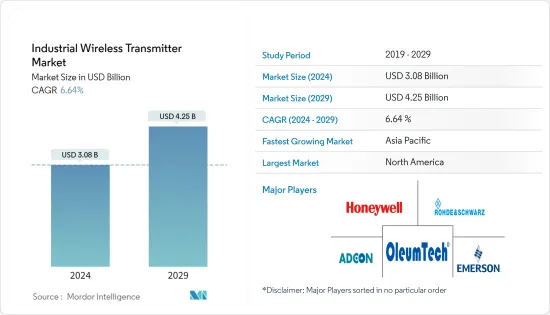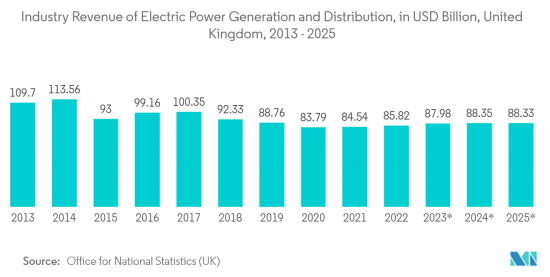PUBLISHER: Mordor Intelligence | PRODUCT CODE: 1403842

PUBLISHER: Mordor Intelligence | PRODUCT CODE: 1403842
Industrial Wireless Transmitter - Market Share Analysis, Industry Trends & Statistics, Growth Forecasts 2024 - 2029

The Industrial Wireless Transmitter Market size is estimated at USD 3.08 billion in 2024, and is expected to reach USD 4.25 billion by 2029, growing at a CAGR of 6.64% during the forecast period (2024-2029).
Key Highlights
- Industrial wireless transmitters network has viewed immense growth as technology companies globally accelerated innovation in the fight against the COVID-19 pandemic. The need for tiny devices is behind advances in electronics, thus, ranging from thermal imaging and faster point-of-care testing to microfluidics-based polymerase chain reaction (PCR) tools and techniques to detect SARS-CoV-2.
- Industrial wireless temperature transmitters and sensors in the market employed Internet of Things (IoT) connectivity to speed up COVID-19 screening. Multiple companies joined forces to develop a series of human body temperature monitoring wearable devices. The wearable devices' transmitters offered real-time data to frontline healthcare workers and let them quickly screen individuals with a high temperature, one of the most common symptoms of COVID-19. Moreover, Shanghai Public Health Clinical Center (SPHCC) used California-based connected health startup VivaLNK's continuous wireless temperature transmitters and sensors network to monitor COVID-19 patients, which decreased the risks of caregivers being exposed to the virus.
- The growing automation and robotics industry, growing demand for a wireless transmitter network in asset monitoring, security, and transportation, and improved reliability with communication technology advancements are the influential factors driving the industrial wireless transmitter market.
- These transmitters are primarily used in factory settings for data monitoring of production flow. These also find applications in defense, building automation, and other industries, like materials handling and food and beverage.
- Due to the increased government regulation for the increased use of transmitters for safety, the demand for wireless transmitters is growing. For example, the areas with challenging environmental conditions, such as extreme high pressure, high temperature, etc. With the help of industrial wireless transmitters, it becomes easy to control and monitor the facility from a safe distance continually. They help to acquire the data from locations that are difficult to access.
- Further, transforming the growth of smart homes and buildings, smart cities, and smart factories demand the use of industrial wireless transmitters, owing to the small form factor, low power consumption, high precision, and ability to control and monitor ambient parameters (such as humidity, pressure, and air quality) in smart homes with the help of wireless technologies.
- As the automotive industry strives to comply with worldwide environmental regulations, the efforts to boost efficiency and achieve better control of engine systems are more crucial than ever. These applications demand efficient wireless transmitter networks to accurately monitor conditions through Bluetooth technology, and battery-free radio frequency identification (RFID) technology enhances efficiency by concentrating on non-critical systems inside vehicles.
- In November 2022, OleumTech introduced two new Hydrogen Sulfide (H2S) Gas Detection Transmitters: one to its OTC Wireless Sensor Network platform and the other to its H Series hardwired process instrumentation product line. The new H2S Transmitters were designed to continuously monitor air quality and generate alarms when H2S levels exceed user-configured setpoints.
- Further, in June 2022, Optex Co., Ltd. launched the Multi-Converter OWU-300M Series IoT wireless units, which use LTE-Cat M1*1 as their communication standard. Optex's IoT wireless units make IoT possible by simply connecting existing transmitters, sensors, and switches, allowing for simple monitoring of sensor data and operational status from remote locations.
Industrial Wireless Transmitter Market Trends
Energy and Power is Expected to Hold a Significant Share
- The energy and electricity sector is the primary end-user group for industrial wireless transmitters. Due to the high deployment rate of wireless solutions, such as wireless transmitters networks, etc., and their ease of installation even in difficult-to-reach locations, wireless transmitters are widely used in the industry.
- Unlike wired transmitters, wired transmitters do not require any signal wiring to return to a corresponding wireless gateway. The use of battery-powered transmitter modules eliminated the requirement for power wiring in recent years. Modern wireless transmitters can be deployed anywhere to monitor almost anything because of their flexibility.
- In the case of the power and energy sector, numerous pieces of equipment, including steam traps, heat exchangers, pumps, compressors, and pressure relief valves, which were previously difficult to monitor and frequently expensive to maintain using wired technology, can now be equipped with wireless transmitters.
- The increasing power generation activities globally are anticipated to rev the studied market's growth. For instance, according to Electric Power Engineers, LLC, the electricity generation in Brazil amounted to more than 677 terawatt-hours in 2022 after growing steadily for a few years. Hydropower is observed to be the most crucial electricity generation source in Brazil, accounting for more than 60 percent of the country's output in 2022. In 2021, the electricity generation in Brazil amounted to 656.11 terawatt-hours.
- Vendors are expanding their manufacturing facility in the market, further creating opportunities for the studied segment. According to the Brazilian Electricity Regulatory Agency, the installed capacity for electricity generation in Brazil increased from 181.61 gigawatts in 2021 to 189.13 gigawatts in 2022.

North America Holds a Significant Market Share
- Demand for wireless transmitters is mainly driven by North America's high manufacturing activity, which contributes more than 23 percent of the region's gross domestic product (GDP). Almost all end-user verticals contain a clear prognosis for the area. The region's primary sources of demand for industrial-grade wireless transmitters are expected to be energy, power, and industrial automation.
- With investment roll-outs by the Biden government to revive the pandemic-hit US economy, infrastructure, and the electronics industry are marked as the primary beneficiaries alongside the growth of small and medium-sized enterprises. The infrastructure and electronics industry are heavy users of industrial control systems' hardware products, including wireless transmitters, and are expected to have a direct positive effect.
- Due to the use of automation, robots, the Internet of Things, and other connected solutions in the industrial sector, the region is anticipated to include a significant market share throughout the projected period.
- A surge in shale gas exploration and refining activities is predicted to impact the wireless transmitter market significantly. Wireless transmitters are used in the shale gas industry to track oil and gas flow, oil tanker levels, and pressure during oil extraction. As a result, they are essential in controlling resource movement and storage. As shale gas extraction in North America receives more attention, this industry is projected to use wireless transmitters more frequently.
- The number of smart devices used in manufacturing facilities expanded across the region due to these tools' ability to let managers and supervisors assess the performance of workers and equipment from any location. As a result of these modifications, the system now requires the integration of wireless transmitters.
- With the increasing adoption of smartphone devices in the US, the demand for industrial wireless transmitters is expected to increase simultaneously in the market. As per the US Census Bureau and Consumer Technology Association, smartphone sales in the US are expected to rise to USD 74.7 billion in 2022 compared to USD 73 billion in 2021. With the rising adoption of smartphones in the market, the demand for wireless transmitters is also expected to grow at the same speed.
Industrial Wireless Transmitter Industry Overview
The industrial wireless transmitter market is marked by fragmentation and intense competition, featuring numerous prominent players vying for market share. Many of these companies are expanding their market footprint through the acquisition of contracts and the introduction of innovative products and services. Moreover, businesses operating within this sector are proactively engaging with startups specializing in industrial wireless transmitter technology to enhance their product capabilities.
In March 2023, Honeywell International Inc. introduced its Versatilis Transmitters, designed for the condition-based monitoring of rotating equipment such as pumps, motors, compressors, fans, blowers, and gearboxes. Honeywell's Versatilis Transmitters are engineered to provide precise measurements for rotating equipment, delivering valuable insights that can enhance safety, availability, and reliability across various industries.
In May 2022, Monnit unveiled its intrinsically safe ALTA-ISX Long-Range Wireless transmitters, specifically tailored to safeguard workers and facilities operating in industrial environments with explosive atmospheres. This advancement demonstrates Monnit's commitment to promoting safety in challenging industrial settings.
Additional Benefits:
- The market estimate (ME) sheet in Excel format
- 3 months of analyst support
TABLE OF CONTENTS
1 INTRODUCTION
- 1.1 Study Assumptions and Market Definition
- 1.2 Scope of the Study
2 RESEARCH METHODOLOGY
3 EXECUTIVE SUMMARY
4 MARKET INSIGHTS
- 4.1 Market Overview
- 4.2 Technology Overview
- 4.3 Industry Attractiveness - Porter's Five Forces Analysis
- 4.3.1 Bargaining Power of Suppliers
- 4.3.2 Bargaining Power of Buyers
- 4.3.3 Threat of New Entrants
- 4.3.4 Threat of Substitute Products
- 4.3.5 Intensity of Competitive Rivalry
- 4.4 Assessment of Impact of Key Macroeconomic Trends on the Market
5 MARKET DYNAMICS
- 5.1 Market Drivers
- 5.1.1 Growing Adoption of IoT in Industrial Space
- 5.1.2 Proliferation of Industrial Control Systems
- 5.2 Market Restraints
- 5.2.1 Security Challenges of Wireless Communication
6 MARKET SEGMENTATION
- 6.1 Type
- 6.1.1 General Purpose
- 6.1.2 Level Transmitters
- 6.1.3 Pressure Transmitters
- 6.1.4 Temperature Transmitters
- 6.1.5 Flow Transmitters
- 6.1.6 Other Types
- 6.2 End User
- 6.2.1 Energy and Power
- 6.2.2 Food and Agriculture
- 6.2.3 Industrial Automation
- 6.2.4 Water and waste water Treatment
- 6.2.5 Other End-users
- 6.3 Geography
- 6.3.1 North America
- 6.3.2 Europe
- 6.3.3 Asia Pacific
- 6.3.4 Latin America
- 6.3.5 Middle East and Africa
7 COMPETITIVE INTELLIGENCE
- 7.1 Company Profiles
- 7.1.1 Emerson Electric Company
- 7.1.2 Honeywell International Inc.
- 7.1.3 Rohde & Schwarz GmbH & Co. KG
- 7.1.4 Adcon Telemetry GmbH
- 7.1.5 OleumTech Corporation
- 7.1.6 Inovonics Corporation
- 7.1.7 Cooper Industries Inc. (Eaton Corporation PLC)
- 7.1.8 Phoenix Contact
- 7.1.9 Ascom Wireless Solutions AG
- 7.1.10 Siemens Corporation
- 7.1.11 Schneider Electric Corporation
- 7.1.12 Keri Systems Inc.
8 INVESTMENT ANALYSIS
9 MARKET OPPORTUNITIES AND FUTURE TRENDS




